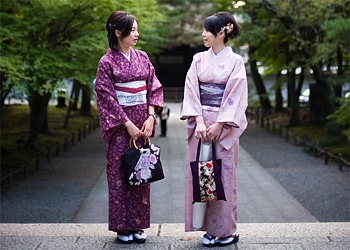Japan: The Best Of Old And New
| For the April/May 2009 issue of ISLANDS magazine, contributing editor Joe Yogerst tunes into the national spirit of Japan by finding intersections between the ancient and modern cultures. Here is how his story begins: | |
| Can this get any stranger? I'm on one of the top floors of a high-rise in Tokyo, eating lunch in a "cosplay cafe," so called because both patrons and staff dress in costumes and play roles. My waitress, who doesn't look more than a couple months out of high school, is using a squeezy ketchup bottle to draw a blood-red heart on my omelet. That seems pretty freaky in and of itself. But she's also clad in a frilly maid's outfit, her jet- black hair tied with a pink bow, her feet squished into black pumps. Three other young women in similar outfits glide along the lunch counter and through the lounge area with its red-and-white shag-carpet seats, rendering their own condi- ment artwork, having photos snapped with adoring guests & occasionally bursting into song. Welcome to another day in modern Japan, a nation where escapism reaches extremes and whose popular culture now has worldwide impact. In my day, it was British pop culture that had the greatest influence on American youth. But my own kids prefer sushi to fish and chips, watch anime rather than Beatles movies and snuggle up to Hello Kitty instead of Winnie the Pooh. And it's not just because we live on the West Coast and feel more affinity for the Pacific world. Just about anywhere you go these days, Japanese culture is cool. Tucked up into the northwest Pacific, the Japanese islands have a tradition of seclusion, and the islanders have always relished their unique- ness. One might expect that would diminish with modern air travel, television and the Internet. |
View Photo AlbumView Larger Map|| But rather than becoming more like everyone else, the Japanese and their sprawling island home have become more distinct. (To read the full story, get the digital version of the April/May issue.)Plan Your Trip: Japan * Fly nonstop from Los Angeles (LAX) to Tokyo (NRT) on Korean Air. koreanair.com * Stay at the Hotel Seiyo-Ginza in downtown Tokyo, a stylish modern boutique within walking distance of the fish market, main train station and all that Ginza shopping, seiyo-ginza.com. Those who prefer big hotels should consider The Peninsula Tokyo, which offers five-star panoramic views of the Imperial Palace Gardens, peninsula.com. Kyoto's most convenient digs are at the Hotel Granvia Kyoto, which towers right above the train station. The Sky Lounge bar offers awesome views of Kyoto, granviakyoto.com. For a different take on Kyoto, rent a machiya (traditional Japanese-style townhouse) near the medieval Gion or across the river in the market district. The romantic wooden structures are all fully restored with modern bathrooms and kitchens and are filled with art and antiques. kyoto-machiya.com * Eat yakitori (grilled meats) in outdoor restaurants beneath the brick railway arches of the Yurakucho district in downtown Tokyo. Not only is the food great, but the beer is cheap and the conversation lively. Tokyo's absolutely best sushi is found in the tiny restaurants (such as Ryu-zushi) that cluster along two narrow lanes inside Tsukiji Fish Market. And the best time to eat is the crack of dawn, when the tuna and other seafood are literally fresh off the boat. And don't forget to chase it with copious amounts of sake. For a totally different vibe, pop into one of Akihabara's innumerable "maid cafes" for an omelet slathered in ketchup hearts. MaiDreamin offers English menus and has two branches in Akihabara (third floor of the Zeniya Building and the sixth floor of the Sumiyoshi Building). maidreamin.com * Get around the islands with a Japan rail pass, which must be purchased before arrival in Japan. Train schedules are posted online, and be sure to reserve your seat the day before travel, especially on popular routes like Tokyo to Kyoto. japanrailpass.net * Fight like a samurai or wrestle like a sumo after taking workshops offered by H.I.S. Experience Japan. Courses range from Samurai Sword Action or A Day in the Life of a Sumo Wrestler to more tranquil pursuits like Make Your Own Sushi and Japanese Potter, hisexperience.jp. In Kyoto, Iori's ORIGIN Program offers workshops in a variety of traditional arts, including the tea ceremony, calligraphy, Noh drama dance, Zen meditation and flower arrangement. kyoto-machiya.com * Explore the weird and wonderful world of Japanese manga (comic books) and anime (animation) at the Tokyo Anime Center in Akihabara. animecenter.jp * Watch Kabuki at the legendary Kabuki-Za Theatre in Tokyo. Full-length Kabuki can run very long, but visitors can purchase separate admission to the three or four shows that comprise an entire play. kabuki-za.co.jp * Learn more at jnto.go.jp.|
